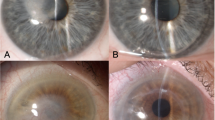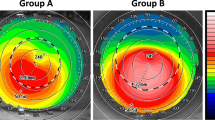Abstract
Background
To discuss the efficacy and visual outcomes of different types of lamellar keratoplasty (LK) for the treatment of peripheral corneal perforation.
Methods
Sixty patients (67 eyes) with peripheral corneal perforation underwent semilunar LK (16 eyes), crescentic LK (12 eyes), biconvex LK (13 eyes), annular LK (11 eyes) and total LK (15 eyes) respectively. The applied type of LK for each involved eye was decided by different sizes and shapes of corneal ulceration and perforation. Postoperative visual acuity (VA), corneal astigmatism and postoperative complications were studied during a 7- to 21-month follow-up.
Results
VA showed no statistical difference preoperatively (P = 0.18), but it was statistically different postoperatively (P < 0.01) in eyes with different types of LK. Postoperative VA in eyes with semilunar LK, crescentic LK and total LK was statistically better than that before surgery (all P values <0.05). Postoperative corneal astigmatism in different types of LK was statistically different (P < 0.01). Semilunar and crescentic LK had the lowest astigmatism, while biconvex LK had the highest. The main postoperative complications were leakage at the graft–host interface, graft rejection and initial disease recurrence.
Conclusion
LK is an effective procedure in eyes with peripheral corneal perforation. Different sizes and shapes of LK can influence postoperative VA due to different degrees of astigmatism. Yet postoperative astigmatism can be reduced by making well-matched grafts and preserving the uninvolved tissue to the largest extent.











Similar content being viewed by others
References
Akpek EK, Altan-Yaycioglu R, Gottsch JD, Stark WJ (2001) Spontaneous corneal perforation in a patient with unusual unilateral pellucid marginal degeneration. J Cataract Refract Surg 27:1698–1700
Lamp Z, Békési L, Csutak A, Berta A (2003) Two cases of Terrien’s marginal degeneration treated with peripheral full thickness keratectomy, and followed-up by computer-assisted corneal topography. Klin Monatsbl Augenheilkd 220:404–410
Synek S, Synková M (2005) Bilateral Terrien’s degeneration treated by corneoscleral graft transplantation. Cesk Slov Oftalmol 61:106–109
Jonas JB, Rank RM, Budde WM (2001) Tectonic sclerokeratoplasty and tectonic penetrating keratoplasty as treatment for perforated or predescemetal corneal ulcers. Am J Ophthalmol 132:14–18
Riedel T, Seitz B, Langenbucher A, Naumann GO (2001) Morphological results after eccentric perforating keratoplasty. Ophthalmologe 98:639–646
Varley GA, Macsai MS, Krachmer JH (1990) The results of penetrating keratoplasty for pellucid marginal corneal degeneration. Am J Ophthalmol 110:149–152
Davis EA, Azar DT, Jakobs FM, Stark WJ (1998) Refractive and keratometric results after the triple procedure: experience with early and late suture removal. Ophthalmology 105:624–630
Pineros O, Cohen EJ, Rapuano CJ, Laibson PR (1996) Long-term results after penetrating keratoplasty for Fuchs’ endothelial dystrophy. Arch Ophthalmol 114:15–18
Price FW Jr, Whitson WE, Marks RG (1991) Progression of visual acuity after penetrating keratoplasty. Ophthalmology 98:1177–1185
Chern KC, Meisler DM, Wilson SE, Macsai MS, Krasney RH (1997) Small-diameter, round, eccentric penetrating keratoplasties and corneal topographic correlation. Ophthalmology 104:643–647
Riedel T, Seitz B, Langenbucher A, Naumann GO (2002) Visual acuity and astigmatism after eccentric penetrating keratoplasty - a retrospective study on 117 patients. Klin Monatsbl Augenheilkd 219:40–45
Kerényi A, Süveges I (2003) Corneal topograp;hic results after eccentric, biconvex penetrating keratoplasty. J Cataract Refract Surg 29:752–756
Shimazaki J (2000) The evolution of lamellar keratoplasty. Curr Opin Ophthalmol 11:217–223
Soong HK, Farjo AA, Katz D, Meyer RF, Sugar A (2000) Lamellar corneal patch grafts in the management of corneal melting. Cornea 19:126–134
Saini JS, Jain AK, Sukhija J, Saroha V (2003) Indications and outcome of optical partial thickness lamellar keratoplasty. Cornea 22:111–113
Richard J, Paton D, Gasset A (1978) A comparison of PK and lamellar keratoplasty in the surgical management of keratoconus. Am J Ophthalmol 86:807–811
Soong HK, Katz DG, Farjo AA, Sugar A, Meyer RF (1999) Central lamellar keratoplasty for optical indications. Cornea 18:249–256
Terry MA (2000) The evolution of lamellar grafting techniques over twenty-five years. Cornea 19:611–616
Panda A, Bageshwar LM, Ray M, Singh JP, Kumar A (1999) Deep lamellar keratoplasty versus penetrating keratoplasty for corneal lesions. Cornea 18:172–175
Shimazaki J, Shimmura S, Ishioka M et al (2002) Randomized clinical trial of deep lamellar keratoplasty vs penetrating keratoplasty. Am J Ophthalmol 143:159–165
Raizman MB, Sainz de la Maza M, Foster CS (1991) Tectonic keratoplasty for peripheral ulcerative keratitis. Cornea 10:312–316
Bessant DA, Dart JK (1994) Lamellar keratoplasty in the management of inflammatory corneal ulceration and perforation. Eye 8:22–28
Vanathi M, Sharma N, Titiyal JS, Tandon R, Vajpayee RB (2002) Tectonic grafts for corneal thinning and perforations. Cornea 21:792–797
Panda A, Sharma N, Angra SK, Singh R (1999) Therapeutic sclerokeratoplasty versus therapeutic penetrating keratoplasty in refractory corneal ulcers. Aust N Z J Ophthalmol 27:15–19
Symes RJ, Catt CJ, Sa-ngiampornpanit T, Males JJ (2007) Corneal perforation associated with pellucid marginal degeneration and treatment with crescentic lamellar keratoplasty: two case reports. Cornea 26:625–628
Trimarchi F, Poppi E, Klersy C (2001) Deep lamellar keratoplasty. Ophthalmologica 215:389–393
Hoppenreijs VP, Van Rij G, Beekhuis WH, Rijneveld WJ, Rinkel-van Driel E (1993) Causes of high astigmatism after penetrating keratoplasty. Doc Ophthalmol 85:21–34
Yilmaz S, Ali Ozdil M, Maden A (2007) Factors affecting changes in astigmatism before and after suture removal following penetrating keratoplasty. Eur J Ophthalmol 17:301–306
Mian SI, Shtein RM (2007) Femtosecond laser-assisted corneal surgery. Curr Opin Ophthalmol 18:295–299
Sarayba MA, Maguen E, Salz J, Rabinowitz Y, Ignacio TS (2007) Femtosecond laser keratome creation of partial thickness donor corneal buttons for lamellar keratoplasty. J Refract Surg 23:58–65
Schmitz K, Schreiber W, Behrens-Baumann W (2003) Excimer laser “corneal shaping”: a new technique for customized trephination in penetrating keratoplasty. First experimental results in rabbits. Graefes Arch Clin Exp Ophthalmol 241:423–431
Soong HK, Mian S, Abbasi O, Juhasz T (2005) Femtosecond laser-assisted posterior lamellar keratoplasty: initial studies of surgical technique in eye bank eyes. Ophthalmology 112:44–49
Funnell CL, Ball J, Noble BA (2006) Comparative cohort study of the outcomes of deep lamellar keratoplasty and penetrating keratoplasty for keratoconus. Eye 20:527–532
Pettit TH (1991) Corneoscleral freehand lamellar keratoplasty in Terrien’s marginal degeneration of the cornea-long-term results. Refract Corneal Surg 7:28–32
Author information
Authors and Affiliations
Corresponding author
Additional information
The authors have no financial or proprietary interest in any material or method mentioned in the article.
This study was supported by: Scientific and Technological Projects of Guangdong Province (grant nos. 2004B40501008, 2005B30901016, 2005B50301013).
Rights and permissions
About this article
Cite this article
Huang, T., Wang, Y., Ji, J. et al. Evaluation of different types of lamellar keratoplasty for treatment of peripheral corneal perforation. Graefes Arch Clin Exp Ophthalmol 246, 1123–1131 (2008). https://doi.org/10.1007/s00417-008-0812-9
Received:
Revised:
Accepted:
Published:
Issue Date:
DOI: https://doi.org/10.1007/s00417-008-0812-9




